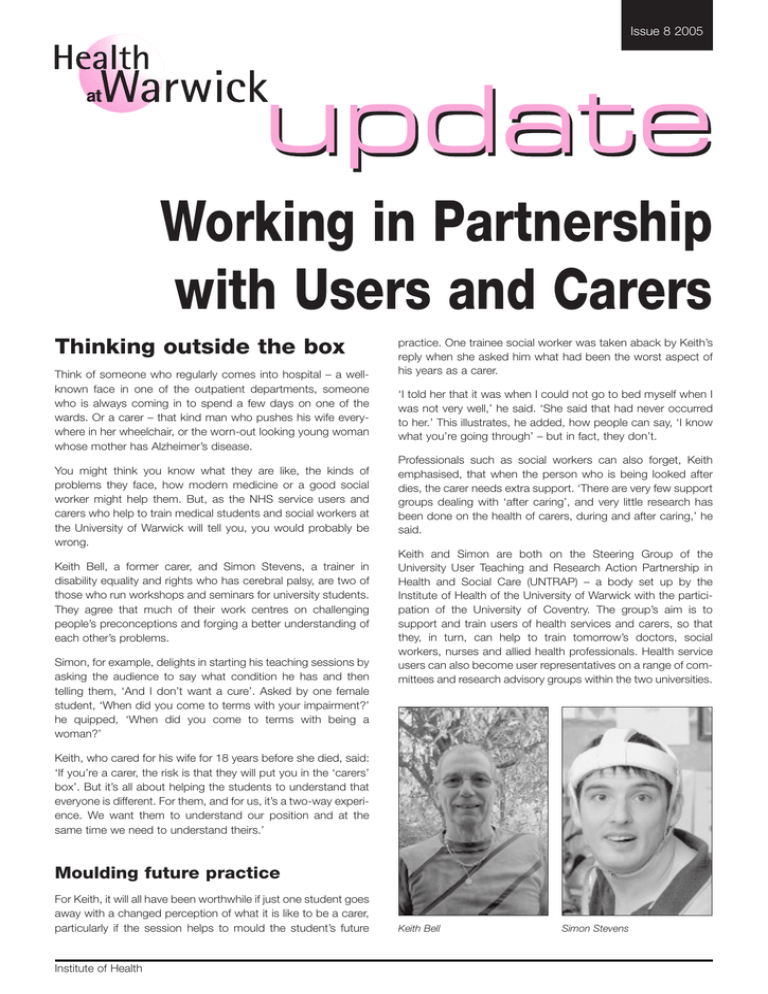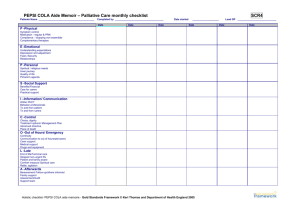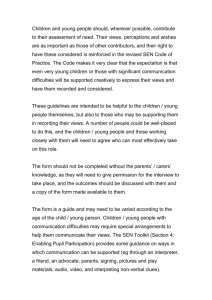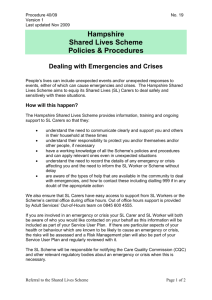Working in Partnership with Users and Carers Thinking outside the box Page 3
advertisement

Issue Page 8 2005 3 Working in Partnership with Users and Carers Thinking outside the box Think of someone who regularly comes into hospital – a wellknown face in one of the outpatient departments, someone who is always coming in to spend a few days on one of the wards. Or a carer – that kind man who pushes his wife everywhere in her wheelchair, or the worn-out looking young woman whose mother has Alzheimer’s disease. You might think you know what they are like, the kinds of problems they face, how modern medicine or a good social worker might help them. But, as the NHS service users and carers who help to train medical students and social workers at the University of Warwick will tell you, you would probably be wrong. Keith Bell, a former carer, and Simon Stevens, a trainer in disability equality and rights who has cerebral palsy, are two of those who run workshops and seminars for university students. They agree that much of their work centres on challenging people’s preconceptions and forging a better understanding of each other’s problems. Simon, for example, delights in starting his teaching sessions by asking the audience to say what condition he has and then telling them, ‘And I don’t want a cure’. Asked by one female student, ‘When did you come to terms with your impairment?’ he quipped, ‘When did you come to terms with being a woman?’ practice. One trainee social worker was taken aback by Keith’s reply when she asked him what had been the worst aspect of his years as a carer. ‘I told her that it was when I could not go to bed myself when I was not very well,’ he said. ‘She said that had never occurred to her.’ This illustrates, he added, how people can say, ‘I know what you’re going through’ – but in fact, they don’t. Professionals such as social workers can also forget, Keith emphasised, that when the person who is being looked after dies, the carer needs extra support. ‘There are very few support groups dealing with ‘after caring’, and very little research has been done on the health of carers, during and after caring,’ he said. Keith and Simon are both on the Steering Group of the University User Teaching and Research Action Partnership in Health and Social Care (UNTRAP) – a body set up by the Institute of Health of the University of Warwick with the participation of the University of Coventry. The group’s aim is to support and train users of health services and carers, so that they, in turn, can help to train tomorrow’s doctors, social workers, nurses and allied health professionals. Health service users can also become user representatives on a range of committees and research advisory groups within the two universities. Keith, who cared for his wife for 18 years before she died, said: ‘If you’re a carer, the risk is that they will put you in the ‘carers’ box’. But it’s all about helping the students to understand that everyone is different. For them, and for us, it’s a two-way experience. We want them to understand our position and at the same time we need to understand theirs.’ Moulding future practice For Keith, it will all have been worthwhile if just one student goes away with a changed perception of what it is like to be a carer, particularly if the session helps to mould the student’s future Institute of Health Keith Bell Simon Stevens Page 2 Value of service users The initiative is in line with Government calls for the NHS and other health organisations to ‘strategically and systematically build patient and public involvement into the way they operate’1. This involvement, says the Department of Health in its document Patient and Public Involvement in the new NHS, should include placing emphasis on the value of service users as teachers in all basic training, involving them in the design of the curriculum, and enlisting their help in assessing students’ communication skills as well as in research governance. Last year, the Department of Health described the involvement of patients, carers and the public as being ‘at the heart of the modernisation of the NHS’2. For some people who are regular users of health services, the internet has made a huge difference to their lives. Simon runs his own company providing services for a whole range of organisations, including disabled individuals. Email and the internet allow him to interact effectively with many more customers and clients than would otherwise be possible. ‘Without the internet, I would be on a bean bag in a care home,’ he said. Clare said: ‘It seemed to us to be very important to look at the reality of people’s lives in terms of whether having access to the internet is going to be useful. Policy and practice needs to be built around what people actually can and will do, taking their circumstances and personal attributes into account.’ Involving patients and carers is, however, not necessarily straightforward. It raises all sorts of questions, both for the patients and carers themselves, and for the health organisations that want to involve them. Who is a carer? How can patients best help improve students’ communication skills? If a carer attends a training session for students, how is care going to be organised for the person he or she normally looks after? How can patients and carers be helped to contribute to training without divulging confidential information about themselves or those they look after? How can users and carers be paid without losing benefits? Can users who have undergone extensive training lose their ability to represent carers in general? Training to meet trusts’ needs Clare Blackburn Issues such as these stimulated the Institute of Health to establish UNTRAP to offer training to patients and carers who are interested in helping to train health and social care professionals. Clare and Janet have recently published two papers describing a study that examined the extent to which people with caring responsibilities can end up falling on the wrong side of the ‘digital divide’3,4. Keith and Simon are both enthusiastic about the development of UNTRAP. Keith said: ‘I applaud Warwick University for taking the initiative, and it is brilliant to be treated with such respect.’ Simon said: ‘There are many different ways of getting involved. It is being done in exactly the right way.’ One of the co-directors of the Institute of Health said: ‘What is unusual about this project is the extent to which we are involving users, and that we are training people. Trusts are starting to implement the new regulations on research governance, which require them to have user representatives on R& D boards and on research advisory groups. They don’t know where to find user representatives who are interested and informed about this role, so what we are doing will help meet this need.’ The members of UNTRAP have ‘hugely varying’ interests. Some people attend only once a year; others are heavily involved. Members come from a huge range of educational backgrounds. UNTRAP welcomes new members. Details of how to become a member are shown on page 4. Access to the internet But do carers and service users in general see the internet as an unalloyed benefit? Clare Blackburn and Janet Read, both of the School of Health and Social Studies at the University of Warwick, have explored the extent to which carers have access to the internet, their use of the internet and their attitudes to obtaining information in this way. Institute of Health Janet Read This study analysed data from a survey, called Carers Online, which was organised by several local authorities with the national voluntary organisation Carers UK. The University of Warwick carried out the research. Researchers sought data on internet use, experience of the internet and views on the internet, via a postal survey sent to 1 in 4 adult carers from the Carers UK database, and all adults on the carers’ databases of the participating local authorities. The survey also gathered information on socioeconomic characteristics and what type of caring the person did. About 40 per cent of the carers to whom the survey was sent responded, giving a sample of more than 3000. Almost 60 per cent said they had access to a computer at home, while 50 per cent said they had used the internet once or more. A third were using the internet daily, and another quarter were using it at least once a week. The most popular use of the internet was to communicate with email; searching for information was less popular. High costs and lack of time Many carers reported difficulties with using a computer and the internet, and over half said they found the internet in general difficult to understand. Almost two-thirds of carers said that time was a major factor affecting use of the internet. Many of those who replied gave the cost of equipment, internet connection and calls as a reason for not using the internet. Page 3 Those who had never used the internet were asked to say what would encourage them to use it. Three out of 10 of this group said that nothing would encourage them to use it (they comprised 14 per cent of all respondents). The factors accounting for lack of use by the remaining respondents included cost of equipment, running costs, and the need for free or cheap, convenient lessons. The results suggested that even people who had not experienced the benefits of the internet at first hand could see what its potential benefits might be. An additional component of the study involved providing 60 adult carers with a computer (including internet access) for 2 to 3 months in their own homes. They were also provided with training and ongoing support at home. The researchers and support workers did not ask the recipients to use the computers for any particular purpose; the carers were simply encouraged to use the equipment for anything useful or interesting, as well as to access the local Carers Online website, which has links to other useful sites. After the computer had been taken back, researchers interviewed the carers about what they had used it for and how it had helped them (or not). impaired children may spend an entire day doing tests and having examinations with a multi-disciplinary team before their parents receive what may be a very distressing diagnosis. The clinicians wanted to explore ways of making the time around diagnosis less stressful for parents. The Principal Investigator, Dr Jugnoo Rahi, Clinical Senior Lecturer in Ophthalmic Epidemiology and Honorary Consultant Ophthalmologist at the Institute of Child Health/Great Ormond Street Hospital in London, collaborated with Professor Gillian Hundt, at the Institute of Health, to elicit the needs of parents of children with severe and moderate visual impairment around the time of diagnosis, and to evaluate the impact of a new service to support them. Helena Tuomainen and Irene Manaras were the research fellows on the project, which was funded by the Wellcome Trust. Jugnoo said: ‘These are children with very complex medical problems, most with additional problems affecting their hearing or their speech, for example. Because many of these disorders are very rare, it can take some time to make a firm diagnosis, and often several clinical teams are involved in their care.’ Most of these carers were providing 50 or more hours of care each week. Two-thirds were women, most were over 45 and most identified themselves as White British or of European origin. Key workers for ophthalmology patients While this group had a computer at home, more than a third reported using it daily, and a similar proportion said they used it most days. All the participants had used the internet for purposes other than caring, and almost all had used it for some activity related to caring. The provision of a key worker – someone who would be parents’ first and main point of contact with hospital staff – had already been demonstrated to be useful in other areas of paediatric care. Jugnoo and her colleagues wanted to find out if they could improve their service to parents if they adopted a similar approach in ophthalmology. No personal support To try to provide more support for families, therefore, in August 2000, the eye department at Great Ormond Street Hospital introduced a Community Link Team. One of the two members of this team would be present while each family and child saw the consultant. The team had use of a dedicated room for seeing families to discuss issues arising from the clinical assessments. Almost two-thirds said using the internet was more convenient and flexible than other methods of obtaining information, such as phoning or visiting the library. Almost half said it saved them time; others said it wasted their time. Some respondents clearly felt the internet was an impersonal way of obtaining information and that it did not provide a ‘human touch’ or any personal support. Janet and Clare believe the results of the study show that carers need either more money or cheaper equipment if they are to take full advantage of the information that is available online. Janet said: ‘By the end of 2005, all public service information has to be provided online. But we fear that as online systems become more mainstream, this could lead to people who already find it difficult to get the information they need – on benefits and the like – becoming doubly disadvantaged. They will be on the wrong side of the digital divide.’ They conclude in their paper in Health and Social Care in the Community: ‘While the internet has the potential to deliver what some people need and want some of the time, for a group that has high levels of need but poor access to the internet, it cannot be seen as the only way to deliver information and support.’ Specialised needs for information Sometimes, the need for information by users of the NHS is highly specialised. At Great Ormond Street Hospital in London, visually Institute of Health The team worker aimed to reiterate or clarify the information given, to advise the family about treatments, and provide information about educational and social services. The Community Link Team would meet families when they returned to the department for other appointments. Jugnoo, Gillian and their colleagues set out to evaluate the impact of the Community Link Team. They identified parents of children who had attended the clinic over the 12 months before the Community Link Team was in place, and parents of children who attended during a 12-month period shortly after its establishment. Both groups were sent a questionnaire, which explored their experience of the care they had received, with particular emphasis on whether the care was respectful and supportive. Health professionals were interviewed about the team’s impact on their work. Home-based interviews were undertaken with a subgroup from both groups to allow them to recount their experiences. As the research group reports in several recent papers5,6,7, those parents who had encountered the Community Link Team, and the health professionals, agreed that the team had provided both emotional and social support, at the same time as providing information, and helping to facilitate access to specific services. Page 4 Praise from parents and staff 5 One parent said the word ‘buffer’ was very apt to describe the role of the team worker: ‘I’ve perceived them as a soft cushion, enveloping the family…’ Others said that, without the help of the team member, they might have missed referrals to other services or been unable to contact other families whose child had the same condition. Rahi JS, Manaras I, Tuomainen H, Lewando Hundt G. (2004) Engaging families in health services research on childhood visual impairment: barriers to, and degree and nature of bias in, participation. British Journal of Ophthalmology 88: 782–787. 6 Rahi JS, Manaras I, Tuomainen H, Lewando Hundt G. (2004) Meeting the needs of parents around the time of diagnosis of disability among their children: evaluation of a novel program for information, support and liaison by key workers. Pediatrics 114: 477–482. 7 Rahi JS, Manaras I, Tuomainen H, Lewando Hundt G. (2005) Health services experiences of parents of recently diagnosed visually impaired children. British Journal of Ophthalmology 89: 213–218. 8 Rahi JS, Manaras I, Barr K. (2003) Information sources and their use by parents of children with ophthalmic disorders. Investigative Ophthalmology & Visual Science 44: 2457–2460. The consultant ophthalmologists welcomed being able to share some roles with the Community Link Team – for example, having the team’s support when comforting the family – or being able to delegate others – for example, asking them to phone a family’s general practitioner. One said: ‘I don’t know how the clinic ran without them before. They are an essential part of my communication with the patient.’ Jugnoo said: ‘We now have a much better understanding of parents’ needs, and of how we can better meet those needs. We have implemented, for the first time, a hospital-based model of a key worker providing information, support and liaison to families of children with visual impairment.’ For anyone else wanting to set up similar services, the team’s published papers summarise some useful practical lessons, she added. Information still needs boosting Gillian states that despite all the improvements in care, it was clear from the results, that parents would still appreciate more information about the specific condition affecting their child. These disorders are often very rare, and it was frequently difficult for parents to find relevant information that they could understand. She said parents reported that they benefited most from the Contact a Family register that enables people to contact families whose children have similar conditions. ‘Alternatively, it might be a good strategy for the hospital’s web pages to indicate where to find goldstandard summaries of these conditions, if they are not included on the hospital’s own website. But, as Janet and Clare found in their research, we must not assume that everyone has access to the internet or feels comfortable with it,’ Gillian said. Indeed, in a separate study by Jugnoo and her colleagues at Great Ormond Street8, parents of children attending the eye department reported that the ophthalmologist remained their most important source of information about their child’s eye condition. All these findings seem to point to the need to offer web-based information alongside other traditional sources of information. References 1 Department of Health. (1999) Patient and Public Involvement in the new NHS. London: DoH. 2 Department of Health. (2004) Patient and Public Involvement in Health: the Evidence for Policy Implementation. London: DoH. 3 Blackburn C, Read J, Hughes N. (In press.) Carers and the digital divide: factors affecting internet use among carers in the UK. Health and Social Care in the Community. 4 Read J, Blackburn C. (In press.) Carers’ perspectives on the internet. British Journal of Social Work. Institute of Health If you are a carer or NHS service user and would like more information about how to enrol for training through UNTRAP, please contact: Cecilia Olivet Research Secretary Institute of Health – SHSS University of Warwick Coventry CV4 7AL Tel: + 44 (0) 24 765 23164 Fax. +44 (0) 24 765 74101 Email: cecilia.olivet@warwick.ac.uk Institute of Health School of Health & Social Studies, The University of Warwick, Coventry CV4 7AL, England Co-Directors Professor Gillian Hundt +44 (0) 24 765 73814 Gillian.Hundt@warwick.ac.uk Dr Hannah Bradby +44 (0) 24 765 23072 H.Bradby@warwick.ac.uk Administration Cecilia Olivet +44 (0) 24 765 23164 (t) +44 (0) 24 765 74101 (f) Cecilia.Olivet@warwick.ac.uk For further details about research in health, medicine and social care at the University of Warwick: www.healthatwarwick.warwick.ac.uk






